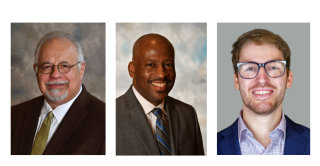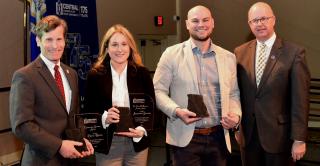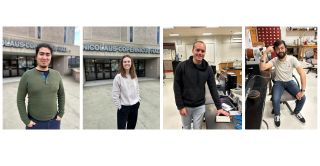
With the spring semester at its mid-point, President Zulma R. Toro hosted an open forum on March 4 to update students on several university initiatives and answer questions. Members of Toro’s executive team were on hand to provide additional details on projects within their purview.
Approximately 25 students attended, and following a light lunch, Toro and her team briefed students on the university’s 175th anniversary celebration this year and encouraged students to participate on related 175th anniversary committees and explore the anniversary-year web page. Students also received special-edition beanies stitched with the university logo and anniversary mark—one of the first promotional anniversary items to be released by the university.
Before opening the floor for questions, Toro shared some institutional data with students, including Central’s total investment in teaching and curriculum development compared to other institutions for fiscal year 2022.
She noted, “Central invests more money in direct instruction than our sister institutions, Charter Oak, and peer institutions nationwide. I thought this was important for you to know that we are always looking for ways to support your educational experience here at Central.”
Toro shared one more set of data on the university’s diversity goals for faculty and student recruitment.
“I am happy to say that the percentage of students at Central that are identified as students of color is 40 percent versus 36 percent of the general population of the state of Connecticut,” Toro said. “That is something for us to be proud of.”
Diversity among faculty and staff is rising more slowly, but Toro identified several recent initiatives to boost the numbers, including refined faculty candidate searches; the anticipated hire of a director of inclusion; and additional seats for students and staff on the President’s Commission on Diversity, Equity, and Inclusion, which was launched in 2020.
The university also plans to partner with the PhD Project, a non-profit organization that works to increase diversity at college-level business schools by helping underrepresented students earn doctoral degrees in business.
Students raised several topics during the question-and-answer session, touching on the campus climate, infrastructure, and student activities such as Greek life.
One student asked if there are plans to install air-conditioning systems in two residence halls and a portion of Memorial Hall, one of two campus dining halls.
Central Chief Operations Officer Sal Cintorino noted that the university has been “methodically going building by building” to install air-conditioning systems and said work on Memorial Hall is slated to begin this summer. The $17 million project will be completed in two phases over the next two years to accommodate building access requirements and routine public health inspections.
Vance and Barrows halls are priority projects for the university, Cintorino explained, but costs and delays at the state funding level will affect the start of construction. The estimated $40 million project will require new windows; updated electrical systems; and additional infrastructure improvements.
“It’s not just about putting a window unit in, it’s everything that comes along with that,” Cintorino said. “Those two projects were slated when we did our 10-year plan to be the next two projects within the res halls. Right now, funding has been stopped at the state level, so it’ll be a very slow process to be able to do projects like that.”
Still, the project is not stalled, and Cintorino noted that President Toro approved funding for the window replacement phase of the project and those plans are under review by the state.
Following an update on counseling services from Director of Counseling and Student Development Michael Russo, one student spoke at length about the need for dedicated interfaith prayer rooms in every building on campus. The campus’s existing Tranquility Room is small, uncomfortable, and limited she said, particularly for Muslim students who must pray five times a day.
Cintorino said he is open to further discussion on an additional interfaith prayer space and Toro agreed, but he noted the logistical challenges of creating a space in every building, including security, scheduling, and accommodation concerns. He also stressed that additional spaces would have to be open to all students.
In response to a student’s question about the university’s efforts to address housing insecurity among students, Toro shared that she is working with the state housing commissioner to potentially launch a pilot program to cover the costs of housing students in need on campus. She added that the university has several factors to consider when allocating space and services to students.
She explained, “Given that we are regulated by the U.S. Department of Education and there are a number of state and federal laws that we have to follow, we have to be extremely careful when we make decisions about providing a support service or something for one group and not providing the same support or service for a different group.”



